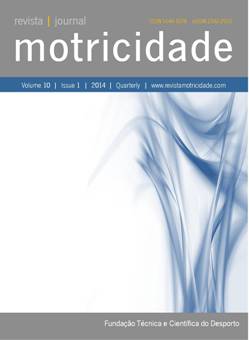Effects of whole-body vibration on muscle strength and power of elderly: A systematic review
DOI:
https://doi.org/10.6063/motricidade.2453Abstract
The aim of this systematic review was to summarize available scientific evidence on the utilization of whole body vibration as an alternative method to promote effective modifications on muscle strength and power in the aging population. Scientific studies were retrieved from the following databases: Medline, Scielo, Lillacs, Cochrane Library, PEDro and Science Citation Index. The PEDro scale was used to assess the quality of the included studies, while content went through a critical analysis. From the 91 studies retrieved, 75 were excluded and 16 attended the selection criteria. From the16, the majority (68.8%) presented from moderate to high methodological quality. Whole-body vibration associated to both isometric and dynamic exercises seemed to constitute an alternative for therapeutic intervention to improve muscular strength and power of healthy elderly. However, due to the characteristics of the designs of the studies reviewed and the threats to their internal validity (i.e., the absence of the control condition to the vibratory stimulus) it was challenging to establish the additional effects of the whole-body vibration on the target population. Divergent findings were found for the whole-body vibration effect on muscular power. It is still necessary to conduct randomized control trials to establish the real effectiveness of this kind of intervention.
Downloads
Published
Issue
Section
License
The authors of submitted manuscripts must transfer the full copyright to Journal Motricidade / Sílabas Didáticas Editions. Granting copyright permission allows the publication and dissemination of the article in printed or electronic formats, and copyrights start at the moment the manuscript is accepted for publication. It also allows Journal Motricidade to use and commercialise the article in terms of licensing, lending or selling its content to indexation/abstracts databases and other entities.
According to the terms of the Creative Commons licence, authors may reproduce a reasonable number of copies for personal or professional purposes, but without any economic gain. SHERPA/RoMEO allows authors to post a final digital copy (post-printing version) of the article on their websites or on their institutions' scientific repository.


